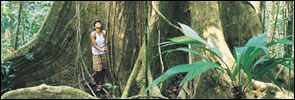by J. Devin Watson ’06 Dr. Maria C. Yaber recently took twelve Hampden-Sydney men to Costa Rica for a tropical biology class. We studied the various plants and animals found in three tropical forests located throughout the country, spending a total of sixteen days in Costa Rica. All of our research was conducted at three biological stations run by the Organization for Tropical Studies (OTS), which also offers several graduate and undergraduate classes at the three stations.
Dr. Maria C. Yaber recently took twelve Hampden-Sydney men to Costa Rica for a tropical biology class. We studied the various plants and animals found in three tropical forests located throughout the country, spending a total of sixteen days in Costa Rica. All of our research was conducted at three biological stations run by the Organization for Tropical Studies (OTS), which also offers several graduate and undergraduate classes at the three stations.
After a week of preparation at Hampden-Sydney, we left early on the morning of May 25 from Raleigh-Durham Airport. After a quick one-hour layover in Miami, we boarded the plane that would take us to San Jose. Going through customs in San Jose was tedious, but we were excited to be in a different country; for some of us, it was our first time leaving the States. We spent the afternoon of our first day exploring San Jose and finding a place to eat. Since the airlines have ceased serving food, we were all famished. We met that night at the Grand Hotel and Casino of Costa Rica and enjoyed an upscale, authentic Costa Rican meal.
The next day we departed slightly later than planned due to some minor thefts and endured a four-hour bus ride to our first research station, Palo Verde. Palo Verde is a dry tropical forest located in the northern pacific coast. We spent a total of five days there. Confronted by numerous clouds of mosquitoes and several inches of rain, the group was unsure how we were going to conduct all of our experiments. Despite the afternoon showers and the droves of mosquitoes, we managed to conduct plenty of field experiments, gathering enough data for six group papers. Fortunately, the food at Palo Verde was exceptionally good, which kept up the group’s morale that was tested by the clouds of mosquitoes. We were able to convince Dr. Yaber to let us spend one of our five days allotted at Palo Verde on the beach at La Playa de Ocotal, a small beach with black volcanic sand, lots of fish, and a nice restaurant/bar. We spent the day swimming, throwing Frisbee, and marveling at the beautiful sights.
We left Palo Verde on Saturday, May 30, to travel to the Wilson Botanical Gardens at Las Cruces biological station, also run by the OTS. We endured a grueling 11-hour bus ride all the way from the northern pacific coast to the southwestern part of the country, about 20 miles from Panama. There we conducted research projects on subjects ranging from epiphytic interactions on palm and deciduous trees to the amounts of insect larvae found in Helliconiae plants. We hiked the various trails around the station and some of us even went swimming in the Java River. Rodo Quir?, the head biologist at Las Cruces, gave us a lecture on the current projects aimed at restoring the nearby pastures to secondary tropical rain forests. We thoroughly enjoyed the spacious accommodations, the reprieve from the mosquitoes, as well as the great food. We were all disappointed to leave.
After four days at Las Cruces, we left for La Selva, a tropical rain forest biological station in the Caribbean lowlands. This would be our last research station and also the place where we would have to collect the most data and report more detailed findings. La Selva contains fifty-six species of snakes, seven of them being poisonous, meaning we had to be careful where we stepped. Two of the three groups studied the behavior of leaf-cutter ants, while others studied the golden-orb spiders and granddaddy long legs. We were relieved once our presentations and papers were finished and were ready to go back to San Jose to buy souvenirs for our families and friends.
We enjoyed our experiences in Costa Rica and would highly recommend the class to future students, especially to students interested in ecology and environmental science or those who simply enjoy hiking and studying exotic animals.